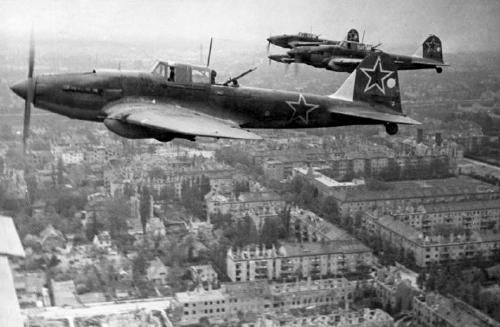World War II: War on the Eastern Front
World War II: War on the Eastern Front
 The war fought between Germany and the Soviet Union became the most dramatic and costly battlefront of World War II. The area was vast -extending for 1,490 miles (2,400 kilometers). The human cost was high as well: Germany lost an estimated 3.5 million lives, battle casualties or prisoners of war. But Germany felt the costs were justified in order to provide Lebensraum - living space for Germans, which was to be located in Eastern Europe and the USSR. Hitler envisioned an easy six-week campaign to conquer the Soviet Union. Instead, it turned into four years of bloodshed and misery. Germany was slowly defeated while the Soviet Union rebuilt itself. Unlike in other war theaters where air power was used for its own military campaigns apart from ground troops, air power on the Eastern Front was used mainly to support ground operations, making it echo the movements and fortunes of the armies.
The war fought between Germany and the Soviet Union became the most dramatic and costly battlefront of World War II. The area was vast -extending for 1,490 miles (2,400 kilometers). The human cost was high as well: Germany lost an estimated 3.5 million lives, battle casualties or prisoners of war. But Germany felt the costs were justified in order to provide Lebensraum - living space for Germans, which was to be located in Eastern Europe and the USSR. Hitler envisioned an easy six-week campaign to conquer the Soviet Union. Instead, it turned into four years of bloodshed and misery. Germany was slowly defeated while the Soviet Union rebuilt itself. Unlike in other war theaters where air power was used for its own military campaigns apart from ground troops, air power on the Eastern Front was used mainly to support ground operations, making it echo the movements and fortunes of the armies.
Operation Barbarossa began at daybreak on June 22nd when 30 bombers attacked airfields in western Russia. Although warned ahead of time by the British and given the exact date by his spy in Tokyo, Stalin felt protected by the Nazi-Soviet pact and ignored the warnings. He refused to relocate his aircraft, and 1,489 aircraft on the ground were destroyed that first day. By the end of the first week, more than 4,000 VVS aircraft had been destroyed.
Soviet bomber pilots were sent out to meet the Germans, but the lack of experienced leadership because of the purges was obvious. The inexperienced pilots flew in tight formations, maintaining steady courses and altitudes. They had neither fighter escorts nor gunners and were easy targets for the well-trained Luftwaffe. The German pilots piled up victories quickly. Werner Molders became the first pilot to pass the 100-victory mark, and Erich Hartmann became Germany's top ace with 352 victories--almost every one earned on the Russian front.
The Germans advanced eastward quickly, capturing cities and taking hundreds of thousands of prisoners. But their rapid move was reckless--the Luftwaffe was forced to abandon damaged aircraft and essential spare parts. The Luftwaffe eventually would lose as many planes to maintenance problems as combat. And no matter how many units the Germans killed, shot down, or captured, more Russian soldiers always arrived.
New Soviet aircraft began arriving too. In spite of the purges, the Soviets had still managed to develop a strong aircraft industry. The MiG 3 high-altitude interceptor, which had been unknown prior to the invasion, debuted. Its top speed exceeded anything the Luftwaffe could produce, although the inexperienced VVS pilots rarely used it to its potential. And the Ilyushin Il-2 Shturmovik, a low-altitude attack aircraft, boasted easy handling, powerful armament, and invulnerability to ground fire that made it a devastating ground attack aircraft against the German Panzer units, who called it the "Black Death." Stalin made the plane a production priority, calling it "like air, like bread" to the VVS.
|







 The war fought between Germany and the Soviet Union became the most dramatic and costly battlefront of World War II. The area was vast -extending for 1,490 miles (2,400 kilometers). The human cost was high as well: Germany lost an estimated 3.5 million lives, battle casualties or prisoners of war. But Germany felt the costs were justified in order to provide Lebensraum - living space for Germans, which was to be located in Eastern Europe and the USSR. Hitler envisioned an easy six-week campaign to conquer the Soviet Union. Instead, it turned into four years of bloodshed and misery. Germany was slowly defeated while the Soviet Union rebuilt itself. Unlike in other war theaters where air power was used for its own military campaigns apart from ground troops, air power on the Eastern Front was used mainly to support ground operations, making it echo the movements and fortunes of the armies.
The war fought between Germany and the Soviet Union became the most dramatic and costly battlefront of World War II. The area was vast -extending for 1,490 miles (2,400 kilometers). The human cost was high as well: Germany lost an estimated 3.5 million lives, battle casualties or prisoners of war. But Germany felt the costs were justified in order to provide Lebensraum - living space for Germans, which was to be located in Eastern Europe and the USSR. Hitler envisioned an easy six-week campaign to conquer the Soviet Union. Instead, it turned into four years of bloodshed and misery. Germany was slowly defeated while the Soviet Union rebuilt itself. Unlike in other war theaters where air power was used for its own military campaigns apart from ground troops, air power on the Eastern Front was used mainly to support ground operations, making it echo the movements and fortunes of the armies.